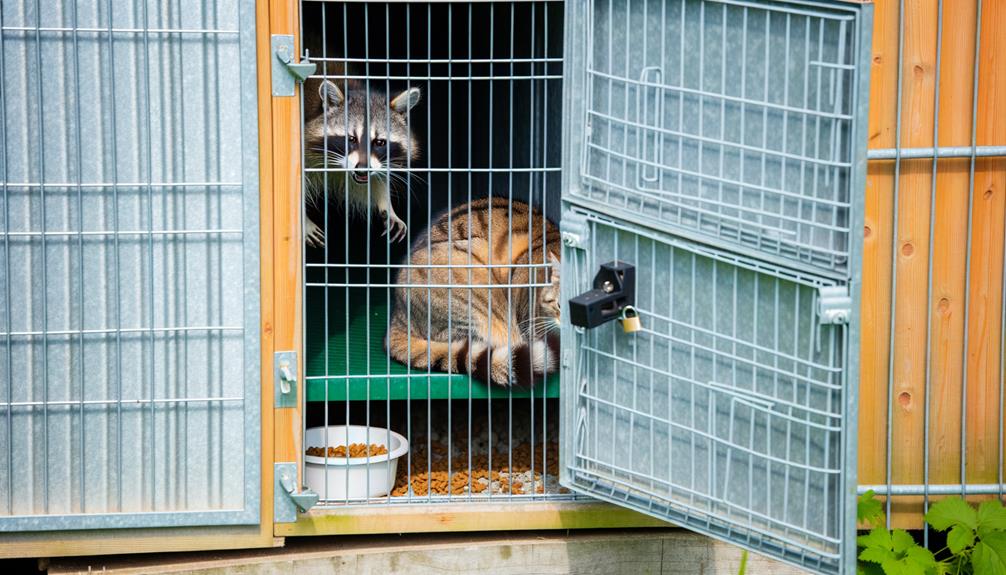Do You Protect Your Barn Cat from Raccoons?
To protect a barn cat from raccoons, adopt a multifaceted approach. First, make sure the cat is regularly vaccinated against diseases like rabies that raccoons can carry.
Store all food and water supplies securely to deter raccoon intrusions and incorporate barn security enhancements such as protective fencing, sturdy shelters, and raccoon-proof cat doors. Scent deterrents like ammonia or cayenne pepper can confuse and deter raccoons.
Food spills should be quickly cleaned and try to feed your cat during daytime. An in-depth understanding of raccoon behavior can holistically support these protective measures.
More insights on these techniques follow next.

Key Takeaways
- Implement protective measures in the barn, including secure cat shelters, raccoon-proof doors, and lighting systems.
- Regularly vaccinate cats against diseases commonly carried by raccoons, such as rabies and distemper.
- Secure food and water sources, using heavy-duty, lockable containers and promptly removing leftovers.
- Use scent deterrents like ammonia, cayenne pepper, and predator urine around the barn to confuse or scare away raccoons.
- Train cats to be nocturnally aware and encourage them to stay close to human activity areas during the night.
Understanding Raccoon Behavior
To effectively protect a barn cat from raccoons, it is essential to first understand the behavior and habits of these nocturnal creatures.
Raccoons, known for their dexterity and adaptability, are omnivorous feeders with a proclivity for scavenging. They are often attracted to barns due to the availability of food, especially cat food, and shelter. Their curiosity and intelligence make them formidable intruders.
Regarding their interaction with cats, raccoons can be aggressive, particularly if they perceive the cat as a threat to food or territory. Understanding these behaviors is critical in devising strategies to safeguard your barn cat from potential raccoon confrontations.
The Importance of Cat Vaccinations
Ensuring your barn cat is fully vaccinated serves as an important measure in safeguarding it against potential diseases that may be transmitted by raccoons. Vaccinations fortify your cat's immune system, equipping it with the necessary defenses to combat infectious agents.
Raccoons are known carriers of diseases such as rabies and distemper, which can be fatal to cats. Vaccinations for these diseases are readily available and should be administered by a licensed veterinarian. Regular revaccination is also key, as it maintains the cat's immunity. Understanding and adhering to vaccination schedules is essential.
It's not just about protecting your cat; it's also about ensuring the overall health of your barn and other animals within. Embrace this freedom to safeguard your cat's health against raccoon-related threats.
Secure Food and Water Sources
While vaccinations play a critical role in protecting barn cats from raccoons, securing food and water sources is an equally essential preventive measure. Raccoons are opportunistic feeders drawn towards easily accessible food and water.
It is important to store these items in raccoon-proof containers, preferably inside a building, away from the cat's sleeping area. If that's not feasible, consider using heavy-duty, lockable containers that raccoons can't pry open.
Additionally, it's advisable to feed the cat during the day and remove leftovers promptly, as raccoons are primarily nocturnal. Clean water should be supplied in a sturdy, non-tip bowl.
Enhancing Barn Security Measures
Enhancing the security of your barn is a critical step in ensuring the safety of your barn cat from raccoons.
Practical measures include the installation of protective fencing, the implementation of lighting systems, and the utilization of secure cat shelters.
Each of these methods contributes to a safer environment, deterring raccoons and reducing the risk to your cat.
Installing Protective Fencing
In a bid to safeguard your barn cat from raccoons, the implementation of protective fencing serves as an important measure. This fencing not only restricts access to raccoons but also provides a safe boundary for your barn cat.
It is essential to make sure that the fence you install is sturdy and high enough to deter raccoons, who are known for their climbing and digging abilities. In addition, using materials like metal or heavy-duty plastic can further enhance the durability of the fence, making it harder for raccoons to breach.
Implementing Lighting Systems
Having secured the perimeter with fencing, the next step in safeguarding your barn cat against raccoons is the strategic implementation of lighting systems.
Adequate lighting serves as a deterrent to raccoons, which are mainly active at night and prefer to operate in the shadows. Motion-sensor lights are particularly effective, startling the raccoons and often causing them to flee.
Solar-powered lights are an eco-friendly and cost-effective choice, requiring no electricity and minimal maintenance. For best results, lights should be placed strategically around the barn's perimeter and potential entry points.
Regular checks should be conducted to make sure all lights are functioning correctly. By implementing these lighting systems, you can enhance barn security measures significantly, providing a safer environment for your barn cat.
Using Secure Cat Shelters
To further safeguard your barn cat from raccoons, consider the use of secure cat shelters within the barn's confines. These shelters provide a safe haven, allowing your cat the freedom to roam while also offering a refuge from potential threats.
When considering a secure cat shelter, keep in mind the following:
- Size: The shelter should be roomy enough for the cat to move comfortably, but not so large that it invites other animals.
- Entrance: An elevated entrance discourages raccoons, which are poor climbers.
- Insulation: Good insulation protects your cat from harsh weather conditions.
- Location: Place the shelter in a quiet, low-traffic area of the barn where the cat will not be disturbed.
Implementing Raccoon-Proof Cat Doors
Securing your barn with a raccoon-resistant cat door can be an effective strategy in safeguarding your feline friend from potential raccoon intrusions. This method is an excellent option for those seeking freedom from constant monitoring of the barn.
Consider the below table to understand the key features of such doors:
| Feature | Importance | Implementation |
|---|---|---|
| Size | A smaller door prevents larger raccoons from entry | Install door of appropriate size |
| Locking Mechanism | Ensures only the cat can enter | Use a door with a magnetic or electronic lock |
| Material | Durable material withstands raccoon's attempts at entry | Opt for doors made of metal or thick, heavy-duty plastic |
The Role of Scent Deterrents
In the field of wildlife management, scent deterrents play a significant role in protecting barn cats from raccoons. These deterrents confuse or scare away raccoons, minimizing their interactions with your barn cat.
Ammonia: Raccoons dislike the smell of ammonia, making it an effective scent deterrent. Soak a cloth in ammonia and place it near potential entry points.
Cayenne Pepper: Sprinkle this around the barn area. The strong smell discourages raccoons from visiting.
Predator Urine: The scent of larger predators, such as coyotes or bobcats, can frighten raccoons away.
Commercial Repellents: There are several products available that use a blend of unpleasant scents to deter raccoons.
Professional Raccoon Trapping Services
Are you still struggling with a persistent raccoon problem despite implementing scent deterrents? It might be time to contemplate professional raccoon trapping services. These experts utilize humane, effective methods to capture and relocate raccoons, reducing the threat to your barn cat significantly.
Trained professionals can identify raccoon activity, set up appropriate traps, and guarantee the safe removal of these animals from your premises. They are well-versed in local wildlife regulations and can ensure all actions are legal and ethical.
Professional raccoon trapping offers a freedom from persistent worries about your cat's safety, allowing you to focus on other important aspects of maintaining your barn. With their help, you can guarantee a raccoon-free environment for your barn cat.
Training Your Cat for Safety
Beyond professional intervention, the safety of your barn cat can also be enhanced through targeted training strategies. Implementing these strategies can equip your barn cat with the necessary skills to protect itself against raccoons and other potential threats.
- Boundary Training:
Teach your cat to stay within the confines of the barn to avoid encounters with raccoons.
- Escape Tactics:
Train your cat in climbing or finding hideouts, essential for quick escapes.
- Nocturnal Awareness:
Cats are naturally nocturnal, but training them to stay alert during peak raccoon activity can be beneficial.
- Food Protection:
Train your cat not to leave food out, as this can attract raccoons.
Conclusion
To sum up, safeguarding barn cats from raccoons requires a multifaceted approach. By understanding raccoon behavior, vaccinating cats, securing food and water sources, enhancing barn security, implementing raccoon-proof cat doors, utilizing scent deterrents, and seeking professional raccoon trapping services, the safety of barn cats can be greatly heightened.
Moreover, training cats to react appropriately towards potential threats complements these measures, ensuring a harmonious co-existence within the rustic charm of a barn setting.






